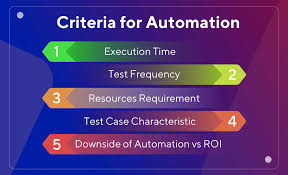Determining When to Automate a Test Case: A Strategic Approach
In the realm of software development and quality assurance (QA), the decision to automate test cases is crucial for optimizing efficiency, improving software quality, and accelerating the release cycle. However, not all test cases are suitable candidates for automation. Knowing when to automate a test case requires careful consideration of various factors to maximize the benefits of automation while minimizing unnecessary effort. Let’s explore the key considerations and best practices for determining when to automate a test case.
1. Repetitive and Regression Tests
Automate test cases that involve repetitive tasks and regression testing. These tests often require executing the same steps and validations repeatedly to ensure that new code changes haven't introduced unintended issues. By automating these tests, teams can save time and resources, allowing manual testers to focus on exploratory testing and more complex scenarios.
2. High-Volume Tests
Tests that need to be executed frequently or across multiple configurations are prime candidates for automation. Examples include compatibility testing across different browsers, devices, or operating systems, as well as performance testing under varying loads. Automation ensures consistent and thorough coverage across diverse environments, minimizing the risk of compatibility issues and performance bottlenecks.
3. Stable and Predictable Tests
Automate test cases that involve stable and predictable components of the software. Tests that interact with well-established functionalities or modules with minimal changes are more suitable for automation. Stable tests yield reliable results, making them ideal candidates for inclusion in the automated test suite to maintain confidence in the software's core functionalities.
4. Business-Critical Scenarios
Identify and automate test cases that cover critical business workflows or user journeys. These tests validate essential functionalities that directly impact user experience, revenue generation, or compliance with regulatory requirements. Automating these scenarios ensures that key aspects of the software are thoroughly tested and validated with each release, reducing the likelihood of costly failures in production.
5. ROI and Maintenance Effort
Evaluate the return on investment (ROI) for automating a test case. Consider factors such as the frequency of execution, complexity of manual execution, and potential savings in time and resources. Balance the upfront effort required to automate the test case against the long-term benefits of reduced regression cycles, improved test coverage, and faster feedback loops.
6. Collaboration with Development and Operations
Involve stakeholders from development and operations teams in the decision-making process. Collaborate to prioritize test cases based on their impact on software quality, release readiness, and overall business objectives. Alignment with agile and DevOps practices ensures that automation efforts support continuous integration, continuous delivery, and rapid deployment cycles effectively.
7. Continuous Evaluation and Adaptation
Recognize that the decision to automate a test case is not static. Continuously evaluate the effectiveness of automated tests and adapt the automation strategy based on evolving project requirements, technological advancements, and changes in the software architecture. Regularly review and update automated test scripts to maintain relevance and reliability in dynamic development environments.
Conclusion
In conclusion, the decision to automate a test case hinges on thoughtful analysis of factors such as test repeatability, criticality, stability, and potential return on investment. By strategically identifying when to automate tests, teams can optimize their testing efforts, enhance software quality, and accelerate time-to-market without compromising on reliability. Embrace automation as a strategic enabler in your QA process, leveraging its power to drive efficiency, consistency, and confidence in delivering high-quality software solutions. As technology continues to evolve, proactive and informed decisions regarding test automation will be instrumental in staying competitive and responsive to market demands.
Join me as we unravel the mysteries of defects, one line of code at a time. Together, let's sharpen our investigative skills and champion quality assurance practices that make a difference.
Thank you for visiting Defect Detective. I look forward to embarking on this enriching journey with you!
Warm regards,
Gagandeep Singh




Comments
Post a Comment